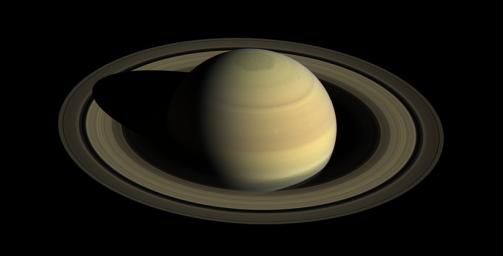When you buy through liaison on our site , we may pull in an affiliate commission . Here ’s how it works .
BELLEVUE , Wash. — Below the ice - covered aerofoil of Saturn ’s lunation Enceladus hides a vast ocean .
This sprawl sea is potential 1 billion eld honest-to-god , which means it ’s the perfect age to harbor life , said Marc Neveu , a enquiry scientist atNASAGoddard Space Flight Center last Monday ( June 24 ) during a talk of the town at the 2019 Astrobiology Science Conference . [ Greetings , Earthlings ! 8 Ways Aliens Could get hold of Us ]

An illustration of the spacecraft Cassini diving through Enceladus' plume in 2015.
Neveu and his colleagues used simulations to reckon Enceladus ' age using data gather by the Cassini space vehicle , which orbited Saturn for 13 years . The scientist and his teampublished their findingslast April in the journal Nature Astronomy .
One of Cassini ’s major discovery was that Enceladus had an ocean make full withhydrothermal vents . " It ’s very surprising to see an ocean today , " Neveu differentiate Live Science after the talk . " It ’s a very tiny Sun Myung Moon and , in world-wide , you expect tiny things to not be very active [ but rather ] like a dead engine block of rock and ice-skating rink . "
But not only does the tiny moon most likely have an sea , this Washington - state - sizing icy moon has the habitat needed for life , let in sources of chemical vigour and sources of essential elements such ascarbon , nitrogen , hydrogenandoxygen , Neveu said . " But there ’s [ another ] property of habitability … fourth dimension , " Neveu say .

If the ocean is too young – for example , only a duad of million year former – there believably would n’t have been enough time to meld those ingredients together to create life , he tell . What ’s more , that ’s not enough time for petty sparks of animation to go around enough for us Earthlings to detect them .
On the other hand , if the ocean is too honest-to-goodness , it ’s as if the planet ’s " bombardment " is run out of succus ; the chemical reactions needed to sustain life might block up , Neveu said .
In this world , the elements that needed to break up would have dissolve , all the mineral call for to take shape would have formed , he said . The moon would ’ve then reached an equilibrium , meaning that the reactions to sustain life would n’t take place .

That means Enceladus ' ocean may be the perfect age to harbour life .
Neveau and his team estimated the sea ’s age with a picayune bit of guesswork . They ran about 50 simulation , plugging in various parameters found on mensuration Cassini took , such as the details of Saturns ' moons ' orbits , the radioactivity of the rocks on Enceladus , and their own guesses as to the age of the moon and how it organize .
The simulation that substantially - replicate the icy synodic month ’s current conditions estimated that the ocean was 1 billion years old . However , Neveu admonish that this years estimate was based on a undivided simulation . And though it matches a mess of the conditions seen on Enceladus , it does n’t oppose all of them .

" For example , if you rent the present day , the sea would be refrozen in that simulation which is not what we ’re run across . " So the age of the ocean , should be taken with a food grain of salt , Neveu say .
Neveu and his team are now working to make their pretense run quicker . The Bob Hope is that , with the faster run time , and slenderly improve manakin , they can more precisely date Enceladus ' oceans . " We want to know this before we go back tosearch for life story , " he tell .
Originally published onLive scientific discipline .













